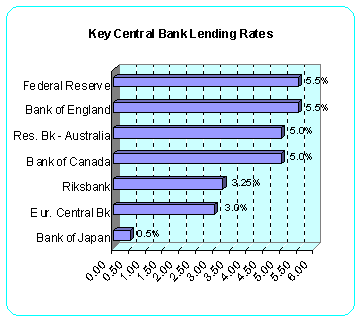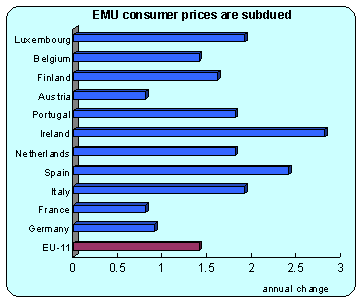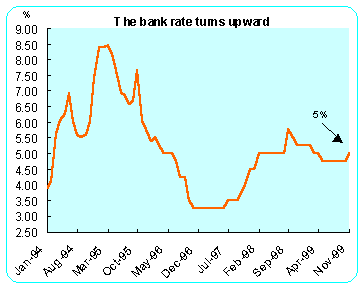The Other Central Banks
Anne D. Picker
International Economist, Econoday

The primary policy goal of central banks is to minimize inflation. The banks differ on what is considered the "acceptable" rate of inflation. The Federal Reserve does not have a specific inflation target. However, the other central banks, such as the Bank of England, state a specific numerical goal or range. Other banks set their goal within a range, which differ from bank to bank.
| Central Bank Inflation Targets | |
|---|---|
| Federal Reserve | none stated |
| Bank of England | 2.5% |
| ECB | under 2% |
| Bank of Canada | 1 to 3% |
| Bank of Japan | none |
European Central Bank
As it approaches its first birthday, the European Central Bank (ECB) is trying to establish itself and its inflation fighting credentials. Founded by the European Union, the ECB is empowered to set monetary policy for eleven of the 15 members, which make up the European Monetary Union. An initial value for their currency was based on exchange rate at the end of 1998.The original primary bank rate was three percent - a number to which the countries converged prior to the official launch at first of the year.
The ECB's governing council performs tasks similar to that of the Federal Reserve Open Market Committee (FOMC). They make decisions affecting the availability and cost of money and credit in member countries. Both make decisions about interest rate and money supply growth targets - although their approach differs in the decision making process.
The European Central Bank decides monetary policy and member national central banks (i.e. the German Bundesbank, Bank of France, etc.) implement it. Together these banks form the European System of Central Banks (ESCB). The president is Wim Duisenberg, a former governor of the Dutch central bank, who is serving an eight year term. The Bank was patterned after the German Bundesbank and follows many of its way of doing business.
The ECB's prime objective is to maintain price stability through interest rate policies. The ECB makes decisions on interest rates by majority vote of its governing council as does the Federal Reserve. The council meets every other Thursday - just as the Bundesbank does - and more frequently than the FOMC. The main monetary instrument is the repurchase rate (repo), which is three percent.
-
The ECB has adapted two policy guides -
- a monetary target of 4.5 percent growth of the M3 measure of money supply
- an inflation target of 2 percent or less as measured by the harmonized index of consumer prices.
The European Central Bank watches money supply very carefully along with inflation. The Bank's inflation target is under two percent. The latest harmonized consumer price index for the European Monetary Union was 1.4 percent (annual rate) despite a 6.4 percent surge in energy prices.
The bank's policy making rate was reduced 50 basis points to 2.5 percent in April to stimulate the flagging German and Italian economies. However, the ECB took a step to establish its inflation fighting qualifications by taking back the cut at their November 4th meeting. The ECB acted not because inflation was evident in EMU price indexes - although there had been oil related increases - but primarily on the basis that money supply or M3 was increasing more rapidly than their 4.5 percent growth rate. This, the ECB felt, eventually might lead to higher inflation. The action was taken despite the continuing weakness in the German economy.
The first chart shows the harmonized consumer price index for the European Monetary Union countries as a gauge of inflation. The CPI remains safely under their target rate of about two percent inflation for the EMU as a whole, although there are some member countries that are either dangerously close to the target or even above the accepted rate. To monitor performance against the inflation target, the ECB uses a basket of economic indicators including an inflation forecast.

The Bank's M3 reference money supply growth rate is about 4.5 percent on an annual basis. M3 is a broad measure of money supply and includes currency in circulation and overnight deposits; other short term deposits; and marketable instruments. A month ago, ECB officials drew attention to M3, which grew at an annual rate of 6.1 percent, by warning that money supply growth and credit expansion requires close scrutiny.

The ECB has no history or track record and is working to establish its anti-inflationary record and credibility. Eleven of the 17 members of the governing council represent the national central banks (Bank of France, Bank of Italy, Bundesbank, etc). In contrast, only five voting members of the 12 members of the U.S. Federal Reserve Open Market Committee are from district reserve banks. Some worry that this decentralization could weaken the ESCB. The governing council is supposed to set interest rates according to conditions in the whole euro area, but there is a continuing worry that national governors will be unduly influenced by conditions in their home country.
Many complain about the lack of transparency of ECB. It does not publish the minutes of its policy meetings, its inflation forecast against which its actions could be judged, or the details of how members vote. The president however, does hold a press conference after the first meeting of the month. At that time, he reads a prepared statement and answers questions from the press.
The ECB is considered to be the most independent central bank ever. The Maastricht Treaty prohibits it from taking orders from politicians. Members of the executive board are appointed for eight year nonrenewable terms to insulate them from pressures to please politicians in order to get reappointed.
The ECB's formal accountability to elected politicians or to the public is more limited than that of other central banks. There is no clear institutional context within which the ECB can answer for its actions. The danger is that without proper accountability it will find it much harder to win the kind of public support enjoyed by the Bundesbank and the Federal Reserve. The dilemma for the ECB is to get the national governments to make the structural and fiscal changes necessary to stimulate growth.
A major hurdle for the European Monetary Union is that member countries are at different stages of the economic cycle. This could cause problems for the ECB because interest rates as set by the ECB will not satisfy all 11 countries. For example, Ireland, Spain and Portugal are experiencing higher growth rates than those of Germany and Italy.
Bank of England
The Bank of England acquired rate setting powers in 1998. In May 1997, the then newly appointed Chancellor of the Exchequer, Gordon Brown, announced that the labor government was giving the Bank of England operational responsibility for setting interest rates. The Bank of England Act of 1998 was implemented on June 1st, 1998. Control of monetary policy now resides with the Bank of England in its Monetary Policy Committee (MPC).
The Committee is composed of the Governor, two Deputy Governors, two Bank Executive Directors, and four experts appointed by the Chancellor. Of late there has been conflict between the two groups concerning the preparation of the analysis by the Bank of England's economic staff. The outside members would like to have their own staff.
The Monetary Policy Committee meets monthly to determine interest rate policy. Unlike the Federal Reserve or the European Central Bank, the Bank of England has an established fixed inflation target of 2.5 percent. Their measure of inflation is the retail price index less mortgages (RPIX).

Interest rate decisions are announced immediately after their meetings. The meeting's minutes, including a record of any vote, are normally published on the Wednesday after the following meeting. The Bank is not entirely free from the Exchequer. Unlike the Federal Reserve which sets its own targets, the Bank of England is assigned an inflation target in the Chancellor's budget message.
The Bank's monetary policy objective is to deliver price stability (as defined by the Government's inflation target) and, without prejudice to that objective, to support the Government's economic policy, including its objectives for growth and employment. The Government's inflation target is confirmed in each Budget statement. The Bank continues to publish a quarterly Inflation Report, which spells out the Bank's forecasts and the thinking of committee members. Needless to say, market participants closely scrutinize the report.
The MPC has changed rates seven times since its formation, most recently on November 4th. One could say that they are micromanaging interest rates. This contrasts rather radically with other central banks that prefer to move once rather than several times. However, cautious moves in 25 basis point increments are similar to the Federal Reserve's policy moves.
Bank of Canada
The Bank of Canada operates in the shadow of the U.S. Federal Reserve Bank. It has an inflation target range of one to three percent. The Bank bases its decisions on the consumer price index. However, because of its proximity to the United States, the Bank also has to factor in U.S. interest rate policy. The spread between United States and Canadian interest rates can cause large capital flows out of Canada into the United States. This in turn affects the value of the Canadian dollar. The Bank issues an inflation report twice a year. Bank governors meet daily. In many instances market players in Canada watch the U.S. economy more than they watch the Canadian economy.

The bank rate is the main "lever" that the Bank of Canada uses to conduct monetary policy. The bank rate is adjusted from time to time to help ensure a low inflation environment favorable for growth and job creation. The day after the Fed raised the fed funds rate 25 basis points to 5.5 percent, the Bank of Canada increased their bank rate by the same amount in order to preserve the 50 basis points spread between Canada and U.S. The Canadian bank rate now stands at five percent. This is the first rate increase since August 27th, 1998, when the central bank intervened to stem a sliding Canadian dollar by lifting its benchmark lending rate a full percentage point to six percent. Since then, the central bank has cut rates fives times by 25 basis points each time.
The spread has interesting currency repercussions. The Canadian dollar has recently firmed and risen against the dollar after a prolonged weak spell. Climbing commodity prices, which comprise about a third of Canada's international trade, have had a positive affect on the Canadian dollar.
The bank rate is the rate of interest that the Bank of Canada charges on short-term loans to financial institutions. The bank rate is an important tool because it is seen as the trendsetter for other short-term interest rates. A fall in the bank rate signals that the Bank of Canada would like to see lower short-term interest rates in the economy. A rise in the bank rate is a signal in the other direction.
End note...
There are many ways to fight inflation and run monetary policy. I have touched on a few. Obviously no two banks behave in the same way, although they are influenced by what others do. In the end, despite international relationships in this ever growing world economy, each bank must look to its own domestic economy and decide what its policy should to be.